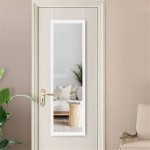Hanging a Heavy Mirror on a Stud Wall
Hanging a heavy mirror on a stud wall requires careful planning and execution to ensure safety and stability. Incorrect installation can lead to the mirror falling, causing damage and potential injury. This article outlines the necessary steps and considerations for successfully hanging a heavy mirror.
Key Considerations Before Starting
Before attempting to hang a heavy mirror, several factors should be assessed:
- Mirror Weight: Accurately determine the weight of the mirror. This information is crucial for selecting appropriate hanging hardware.
- Wall Structure: Confirm the wall is a standard stud wall. Different wall constructions may require alternative hanging methods.
- Stud Location: Precisely locate the wall studs. A stud finder is essential for this task.
- Mirror Dimensions: Measure the mirror's dimensions to determine the ideal hanging points and hardware placement.
- Hardware Selection: Choose heavy-duty hanging hardware rated for the mirror's weight. Consult with a hardware professional if unsure.
Necessary Tools and Materials
Gathering the correct tools and materials beforehand streamlines the hanging process:
- Stud Finder: Essential for locating wall studs accurately.
- Level: Ensures the mirror hangs straight.
- Drill with appropriate drill bits: For pre-drilling pilot holes, if necessary.
- Screwdriver: Compatible with the chosen hanging hardware.
- Heavy-Duty Wall Anchors (optional): If studs are not in the desired location.
- Measuring Tape: For accurate measurements and placement.
- Pencil: For marking stud locations and hanging points.
- Safety Glasses: To protect eyes from dust and debris.
- Heavy-duty Hanging Hardware: Specifically designed for heavy mirrors, such as D-rings, J-hooks, or French cleats.
Locating and Marking Wall Studs
Accurate stud location is paramount for secure hanging:
- Use a Stud Finder: Run the stud finder horizontally across the wall in the area where the mirror will hang.
- Mark Stud Locations: Clearly mark the center of each stud with a pencil.
- Verify Stud Location: Double-check the stud location by tapping the wall. A solid sound indicates a stud, while a hollow sound indicates an empty cavity.
Selecting Appropriate Hanging Hardware
The choice of hanging hardware depends on the mirror's weight and hanging method:
- D-Rings and Screws: A common and reliable method for heavier mirrors. D-rings are attached to the back of the mirror, and screws are driven directly into the wall studs.
- J-Hooks and Wire: Another viable option, but ensure the wire and hooks are rated for the mirror's weight.
- French Cleats: Offer a robust and secure hanging solution, especially for very heavy mirrors. A cleat is attached to both the wall and the mirror, interlocking for a strong hold.
- Weight Capacity: Always choose hardware with a weight capacity exceeding the mirror's weight.
Installing the Hanging Hardware
Follow these steps for installing the selected hardware:
- Attaching Hardware to the Mirror: Carefully follow the manufacturer’s instructions for attaching the chosen hardware (D-rings, J-hooks, or French cleat) to the back of the mirror. Precise placement is crucial for proper balance.
- Marking Wall for Hardware: Measure and mark the corresponding locations on the wall where the screws or other wall-mounted hardware will be installed, ensuring alignment with the previously marked studs.
- Pre-Drilling Pilot Holes (if necessary): If using screws, pre-drilling pilot holes will prevent the wood from splitting and make installation easier. Choose a drill bit slightly smaller than the screw diameter.
- Installing Wall-Mounted Hardware: Carefully install the wall-mounted portion of the chosen hanging hardware, ensuring it is securely fastened to the studs.
Hanging the Mirror
With the hardware installed, the mirror can be hung:
- Careful Lifting: Lift the mirror carefully, ensuring a secure grip.
- Engaging the Hardware: Align the mirror's hanging hardware with the wall-mounted hardware and engage them securely.
- Checking for Stability: Gently test the mirror's stability by applying slight pressure. It should hang firmly without movement.
- Leveling: Use a level to ensure the mirror hangs perfectly straight. Adjust as needed.
Using Wall Anchors (if necessary)
If studs are not located in the desired position, heavy-duty wall anchors can be used:
- Choosing Appropriate Anchors: Select anchors specifically designed for heavy objects and the wall's material (e.g., drywall, plaster).
- Installing Anchors: Follow the manufacturer’s instructions for installing the anchors.
- Attaching Hardware: Attach the wall-mounted hardware to the anchors, ensuring a secure fit.
Safety Precautions
Safety should always be the top priority:
- Use a Helper: Enlist a helper, especially for larger or heavier mirrors.
- Wear Safety Glasses: Protect eyes from dust and debris.
- Proper Lifting Techniques: Lift with your legs, not your back, to avoid injury.
- Secure the Area: Clear the area around the wall to prevent accidents.

A Better Way To Hang Heavy Mirror Hanging Pictures On The Wall
How To Hang A 100 Pound Mirror On Drywall Quora

Hanging Heavy Mirror On Plaster Walls 6 Steps With Pictures Instructables

How To Hang A Heavy Mirror Or Picture On Wall Today S Homeowner

How To Hang A Very Heavy Picture Or Mirror The Best

Mirrors Are Heavy The Hook And Nail Must Go Into A Stud But If Isn T In Right Spot What To Do Hanging Mirror

How To Hang A Heavy Mirror

How To Hang A Heavy Mirror

How To Hang A Large Or Heavy Mirror

How To Hang A Heavy Mirror On Plasterboard Timber Framed Wall








